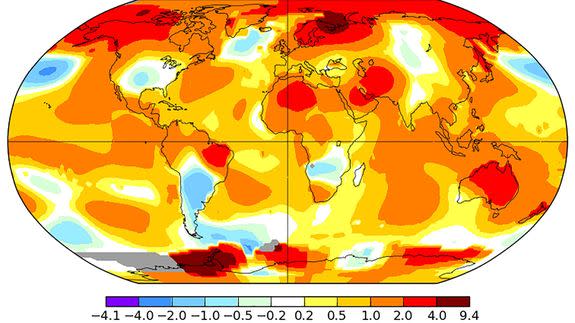Earth's hot streak continues with warmest May since at least 1880

Another month, another shattered global temperature record.
According to preliminary readings from NASA, May 2016 was the warmest such month on record for the planet, dating back to 1880. Global average surface temperatures were 0.93 degrees Celsius, or 1.67 degrees Fahrenheit, above average for the month, beating out the old record, which was set in May 2014.
This makes May the 8th straight warmest month on record in NASA's database. According to the World Meteorological Organization, it was also the warmest northern hemisphere spring on record, in part due to much milder than average conditions in the Arctic.
If the National Oceanic and Atmospheric Administration (NOAA) also ranks May as the warmest such month, it would make it the 13th straight warmest month in NOAA's records, which has never happened before. (Although the two agencies use similar data, they differ in how they analyze global temperature measurements.)

Image: NASA GISS
Gavin Schmidt, the director of NASA's Goddard Institute for Space Studies (GISS) in New York has already predicted that 2016 will be the warmest year on record, beating the record set in 2015. Scientists at NOAA have also said such a record is likely this year.
The end of the streak?
There are signs that the streak of record-breaking months is coming to an end, as ocean temperatures cool in the tropical Pacific Ocean and a La Niña event develops.
Although it came close, May was the first month out of the past eight months that failed to exceed the 20th century average by at least 1 degree Celsius, or 1.8 degrees Fahrenheit. Until October, that 1-degree threshold had not been crossed since NASA's global temperature records began, and it was then exceeded every month from October 2015 through April 2016.

Image: Weatherbell analytics
The threshold is relevant since the Paris Climate Agreement specifies that countries should work to keep human-caused global warming to less than 2 degrees Celsius, or 3.6 degrees Fahrenheit, above preindustrial levels by the year 2100.
Using preindustrial temperature estimates (precise global temperature data from 1750 is not available), the October through April period may have reached that 2-degree threshold, albeit briefly.
May's data means that the 12-month running average of global temperatures has now hit 1-degree Celsius, or 1.8 degrees Fahrenheit, above the 1951-1980 average, according to climate scientist Stefan Rahmstorf.
The Paris Agreement also contains language referring to the need to limit global warming to as low as 1.5 degrees Celsius, or 2.7 degrees Fahrenheit, above the preindustrial average, which was almost certainly reached during that January through April period.
According to an analysis from the news and research group Climate Central, through April, the globe had come close to the 1.5-degree threshold.
However, that analysis compared temperatures to the period from 1881-1910, which are the earliest reliable records from thermometers. Actual preindustrial temperatures are thought to have been even cooler than this baseline shows, which would put the warming above the 1.5-degree line.
But global average temperatures are cooling down a bit, relatively speaking.
Since February set a record for the most unusually mild month, with a temperature anomaly of 1.33 degrees Celsius, or 2.39 degrees Fahrenheit, above average, the monthly temperature anomalies have declined by an average of 0.13 degrees Celsius per month.
If this continues, then June is likely to be close to the warmest such month in NASA's database, but a slightly faster cooling would easily end the streak.

Image: Earth Simulator
The Japan Meteorological Agency, which also tracks global temperatures, ranked May as the second-warmest such month on record, coming in just 0.01 degrees Celsius cooler than May of last year.
El Niño on top of human-caused global warming
The record warmth during 2015-16 was due to a combination of human-caused global warming and a record strong El Niño event.
Now that a La Niña is developing, though, global temperatures are likely to be dampened somewhat.
You can think of El Niño as a driver pressing the gas pedal on a car all the way to the floor, while La Niña is more like a driver still pressing the gas, but at a more moderate (and less dangerous) pace.
However, even La Niña years have been warming as a result of long-term global warming, and it's possible the developing La Niña could set a record for the mildest La Niña year.
For climate scientists, what matters is the long-term trend over decades to centuries, making monthly records much less significant compared to the steady increase in temperatures throughout the 20th and 21st centuries.
